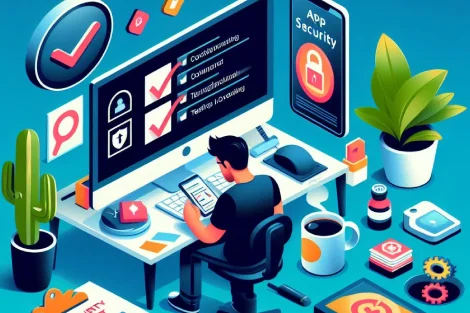Essential App Security Checklist Every Developer Should Be Aware Of

Introduction
Mobile applications play a significant role in our daily lives. However, with the increasing dependency on mobile apps comes the critical need for robust security measures. Android and iOS, being the most popular mobile operating system globally, are often targeted by malicious actors. Therefore, ensuring the security of applications is paramount for developers.
In this blog post, we'll delve into the essential app security checklist that every developer should be aware of. From authentication mechanisms to data encryption and beyond, we'll explore the best practices to fortify your app's security. Let's dive in!
Best Practices That You Need to Know to Secure your app

Implement Secure Authentication Mechanisms
- Use Strong Password Policies: Enforce password complexity requirements such as minimum length, combination of uppercase and lowercase letters, numbers, and special characters.
- Biometric Authentication: Utilize biometric authentication methods such as fingerprint or facial-recognition to enhance security and user convenience.
- Multi-Factor Authentication (MFA): Implement MFA to add an extra layer of security by requiring users to verify their identity using multiple factors like a password, SMS code, or authentication app.
Encrypt Sensitive Data
- Data Encryption: Utilize strong encryption algorithms like AES (Advanced Encryption Standard) to encrypt sensitive data stored on the device or transmitted over the network.
- Secure Key Management: Implement secure key management practices to protect encryption keys and prevent unauthorized access to encrypted data.
Secure Network Communications
- HTTPS Usage: Always use HTTPS for all network communications to encrypt data in transit and prevent eavesdropping and tampering by malicious actors.
- Certificate Validation: Implement certificate pinning to verify the authenticity of server certificates and prevent man-in-the-middle attacks.
Enforce Proper Authorization and Access Controls
- Role-Based Access Control: Implement RBAC to restrict access to sensitive features or data based on user roles and permissions.
- Fine-Grained Access Controls: Implement granular access controls to ensure that users only have access to the resources and functionalities they need to perform their tasks.
Regularly Update Dependencies and Libraries
- Dependency Management: Keep third-party libraries and dependencies up to date to patch known security vulnerabilities and mitigate risks associated with outdated components.
- Vulnerability Monitoring: Monitor security advisories and subscribe to vulnerability databases to stay informed about the latest security updates and patches for your dependencies.
Apply Code Obfuscation and Minification
- Code Obfuscation: Use tools like ProGuard or R8 to obfuscate your app's code and make it harder for attackers to reverse engineer and analyze.
- Code Minification: Minify your app's code to remove unnecessary whitespace, comments, and unused code, reducing the attack surface and improving performance.
Utilize Secure Storage Solutions
- KeyStore API: Store sensitive data such as encryption keys, API keys, and user credentials securely using Android's KeyStore API, which provides hardware-backed storage for cryptographic keys.
- Encrypted SharedPreferences: Use encrypted SharedPreferences to store sensitive app settings and user preferences securely, protecting them from unauthorized access.
Conduct Thorough Security Testing
- Penetration Testing: Perform penetration testing to identify and exploit security vulnerabilities in your app's infrastructure, APIs, and user interfaces.
- Code Review: Conduct regular code reviews to identify security flaws, insecure coding practices, and potential vulnerabilities in your app's source code.
Monitor and Respond to Security Threats
- Real-Time Monitoring: Implement real-time monitoring and logging mechanisms to detect and respond to security incidents, anomalous behavior, and potential threats.
- Incident Response Plan: Develop an incident response plan outlining the steps to be taken in the event of a security breach, including notification procedures, mitigation measures, and forensic analysis.
Educate Users on Security Best Practices
- User Awareness Training: Provide user education and awareness training on security best practices, such as choosing strong passwords, avoiding phishing scams, and enabling device security features.
- In-App Security Tips: Display in-app security tips and reminders to educate users about potential security risks and encourage them to take proactive measures to protect their data and privacy.
By incorporating these best practices into your app development process, you can enhance the security posture of your app and mitigate the risk of security breaches and data leaks. Remember that security is an ongoing process, and staying vigilant against emerging threats and vulnerabilities is essential to ensure the long-term security and integrity of your app.
Also Read: Mobile Apps vs Website: Which is Better?
Why secure apps are essential for you?

Securing apps is not just a matter of compliance or good practice; it's crucial for safeguarding user trust, protecting sensitive data, and preserving your brand reputation. A security breach can have far-reaching consequences, including financial losses, legal liabilities, and damage to your organization's credibility. By prioritizing app security, you not only protect your users but also mitigate risks and ensure the long-term viability of your app.
Why Hire Innow8 Apps?
At Innow8 Apps, we understand the importance of app security in today's digital landscape. Our team of experienced developers follows industry best practices and employs robust security measures to build secure and resilient Android and iOS applications. Whether you're developing a consumer-facing app or an enterprise solution, you can trust us to deliver high-quality, secure apps that meet your business needs.
FAQs
Why is app security important for developers?
App security is essential for protecting user data, maintaining trust, and mitigating risks such as data breaches and cyber attacks.
How can developers prevent common security vulnerabilities in Android apps?
Developers can prevent common security vulnerabilities by implementing secure coding practices, conducting security testing, and staying informed about the latest security threats and best practices.
What are the key steps in securing an application?
The key steps in securing an application include implementing secure authentication mechanisms, encrypting sensitive data, securing network communications, enforcing proper authorization and access controls, and conducting thorough security testing.
How often should security assessments be conducted for iOS apps?
Security assessments should be conducted regularly, preferably as part of the development lifecycle, to identify and remediate security vulnerabilities promptly.
What measures can be taken to address security breaches in Android and iOS apps?
In the event of a security breach, developers should have an incident response plan in place to mitigate the impact, notify affected users, and take steps to prevent future breaches. This may include patching vulnerabilities, improving security controls, and enhancing monitoring capabilities.
Final Thoughts
In conclusion, securing your app is a multifaceted process that requires diligence, expertise, and proactive measures. By following the best practices outlined in this checklist and partnering with a trusted app development firm like Innow8 Apps, you can build secure, resilient, and successful Android and iOS applications that instil confidence in your users and stakeholders.
Are you ready to build a safer digital future?
Recent Blogs:

How does TikTok make money? - 2023 updated
From advertising to sponsored content, learn how TikTok turns user engagement into a profita...
Read More
5 ways how free apps make money [tactics for ...
Having plans to create a free app? Check out how free apps makes money in 2023 with the leas...
Read MoreHow Much Does An App Like WhatsApp Clone Cost...
Learn the estimated cost of building a WhatsApp clone app with essential features like mess...
Read More